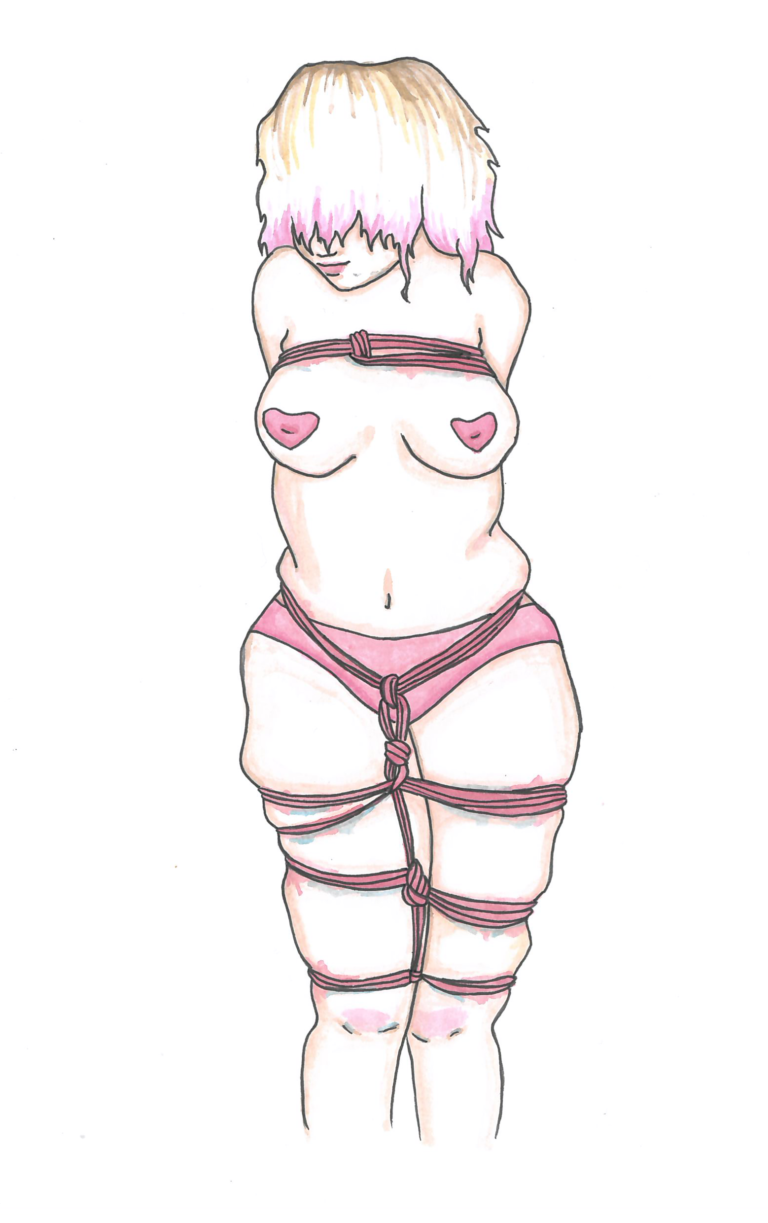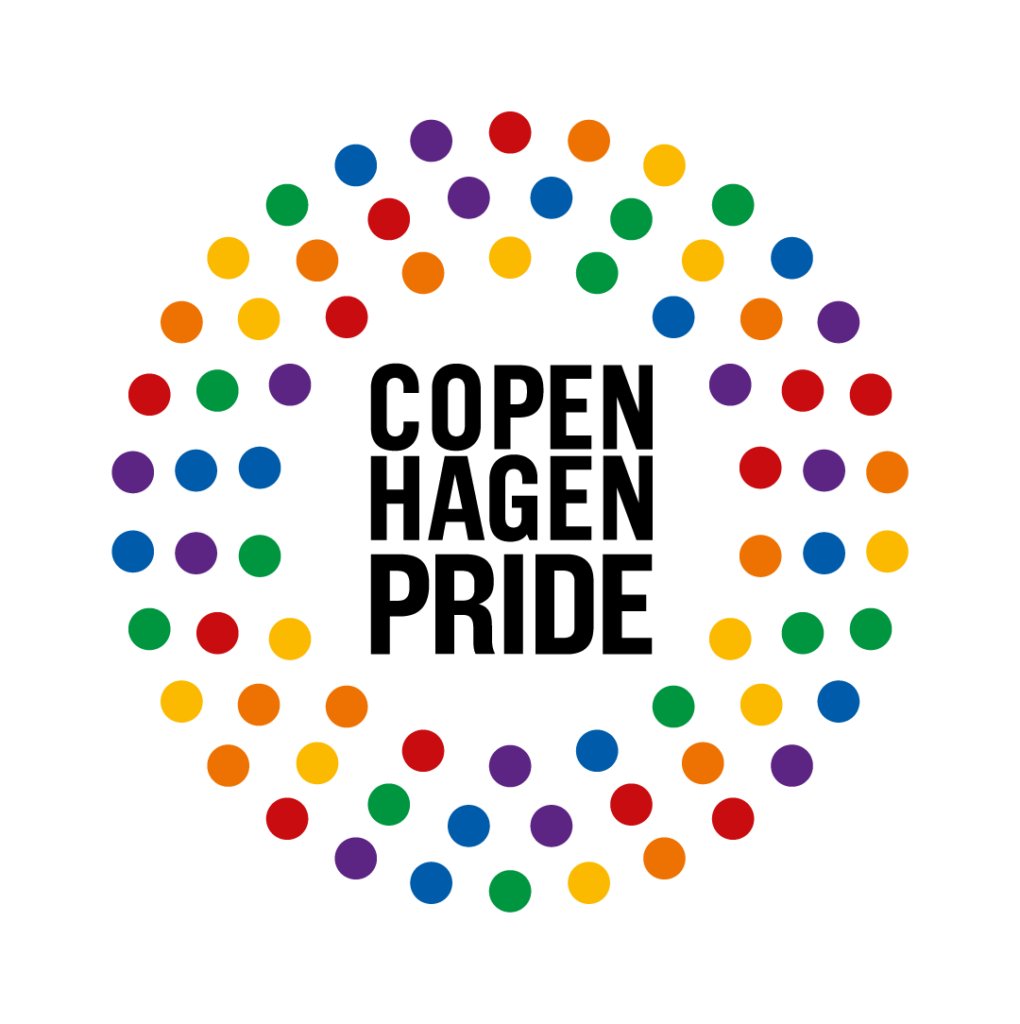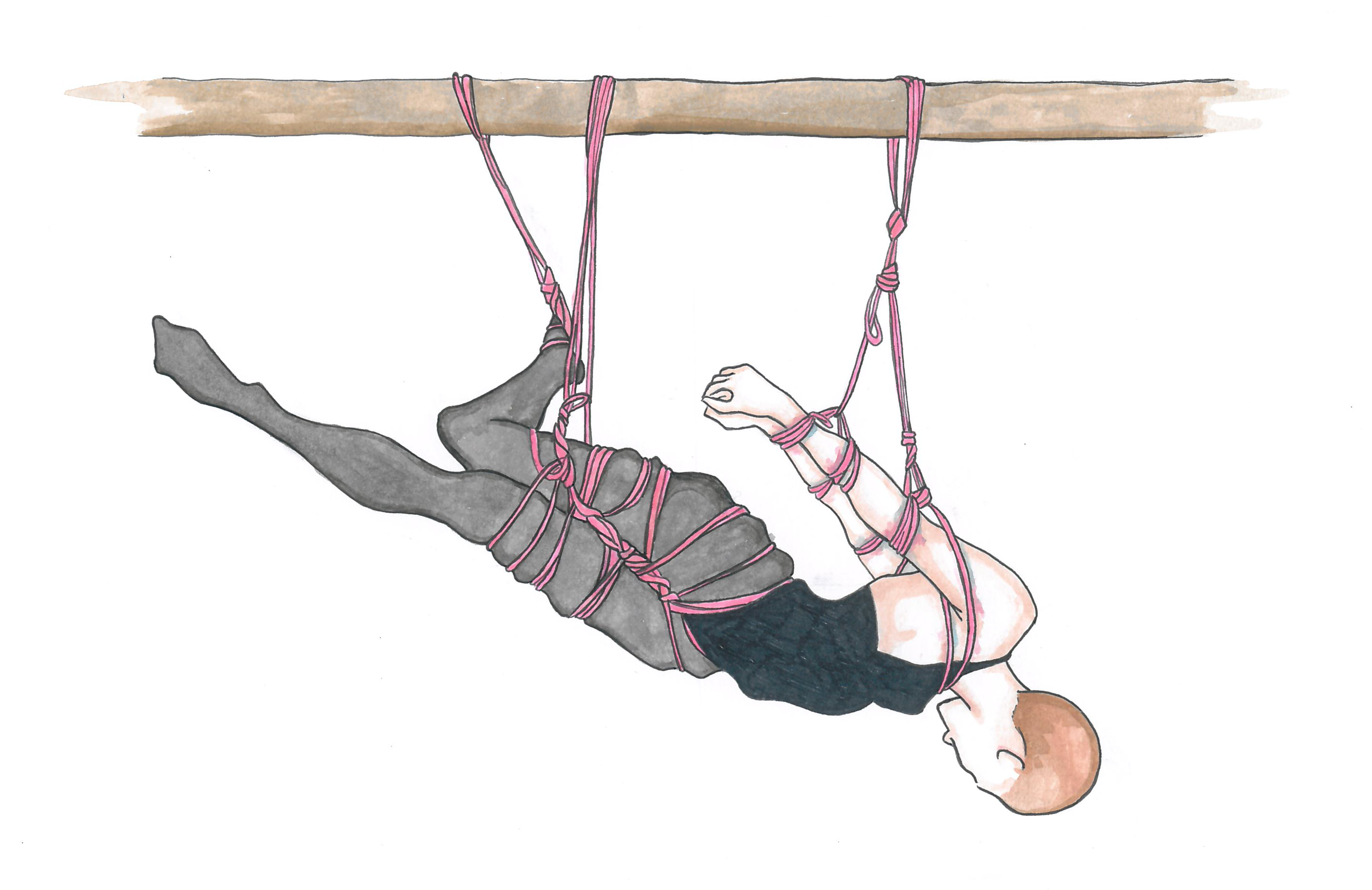
Queer and kinky
Navigating spaces across identities
“It’s about deeper feelings, not about how a person presents”
By N Brown
Illustrations by Sabrina Hansen
This article explores kink – an aspect of identity that, while not the cause of structural oppression, influences a person’s experience of queerness. Through separate conversations with four members of kink communities here in Copenhagen I plan to explore the intersection of queerness in kink and fetish communities. I also want to take a specific look at how the fetish community has a space in the city’s Pride celebrations.
I had the honour of speaking with several people while preparing for this piece. Beatrice – also known as Red Lily – who teaches shibari, focusing on creating an environment where rope is used as a conduit to feelthe person one is interacting with beyond how they are presenting on the surface; Charlotte, who among other roles facilitates the Kink 101 workshop for Copenhagen Pride and has been a member of Excess Club for 15 years; Stephen, one of the founders and organizers of ManiFest.dk, the largest fetish club in Scandinavia which has also participated in Pride for over 15 years; and Anna, a volunteer facilitator/teacher of Queer Rope and Peer Rope for over 7 years as well as a volunteer at the BDSM association SMil.
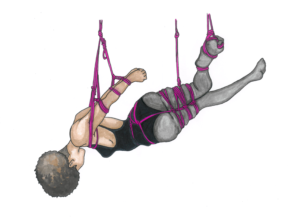
How might queer communities intersect with kink and BDSM?
During my wonderful conversation with Beatrice, we considered the word “queer” and the word “kinky”: indeed “queer” could mean any non-traditional way of living; and what is kinky for one may not be so for another. So, what are the implications when queer people interact with the kink community? Kink, like queerness, is a spectrum with no minimum level.
Where better to see this than at ManiFest fetish parties – a highly mixed space where, among others, the gay, queer, hetero, and swinger communities combine. Each of these communities has a different way of negotiating the space, meaning no single set of ‘rules’ works – and that in turn means it is important to frame the event in a way that creates a common codex for behavior. Stephen, a founding organizer, explained that working with this intersection “is a living thing. We need to be aware of the different languages in a mixed event. It’s a work in progress and I am still working on it because it constantly changes.”
![]()
How might spaces be created where queer people can safely explore kinks, fetishes, and other sexual expressions?
Stephen explains how this is a key consideration for the ManiFest crew. The concept of a ‘safe space’ is in itself a huge responsibility and a dual effort from everyone participating, not just the organizers. Charlotte also spoke to this, in that most people share similar feelings in kink or BDSM spaces, though being queer adds an extra level of consciousness. That’s why it is very important as a queer person to explore this part of one’s identity in an environment where queerness is not something to be conscious of – thereby allowing one to focus on the kink. Consider Maslow’s pyramid of needs: it is very hard to get to the top if the safety needs at the bottom are not solid. As a presenter in a blended space Charlotte recognizes that LGBTI+ participants could feel marginalized, whereas a targeted workshop where people feel they are among queer friends can create a new level of freedom.
Does being kinky affect queerness?
Charlotte expands on this, sharing her experience of facilitating kink workshops, both queer-specific and mainstream. She explains how, regardless of who you are, your gender or your sexual orientation, the questions in workshops are always the same: How do I do kink safely? How do I know what to do? How do I read my play partner? What if I feel insecure?
As a queer person, you indeed tend to be more aware of ‘feeling’ environments and of ensuring you’re not marginalising other participants. With kink, you check in on a person’s feeling and identity EVERY time you play with someone – similar to how people in the queer community often have a hands-on understanding of how your identity may evolve over time.
What about queerness in rope (or shibari/kinbaku)?
Rope is known also as shibari (the ancient Japanese art of bondage tying) or kinbaku (using this in a more sensual direction). It is a type of bondage which can be used both on the floor and in suspension, on one’s own body or with one or more partners. It is a form of edge play with risk of nerve damage, so it is important to research and learn properly before trying. Shibari has traditionally been a binary practice, distinguishing between male/female and top/bottom, but recently there has been a move towards a more inclusive practice.
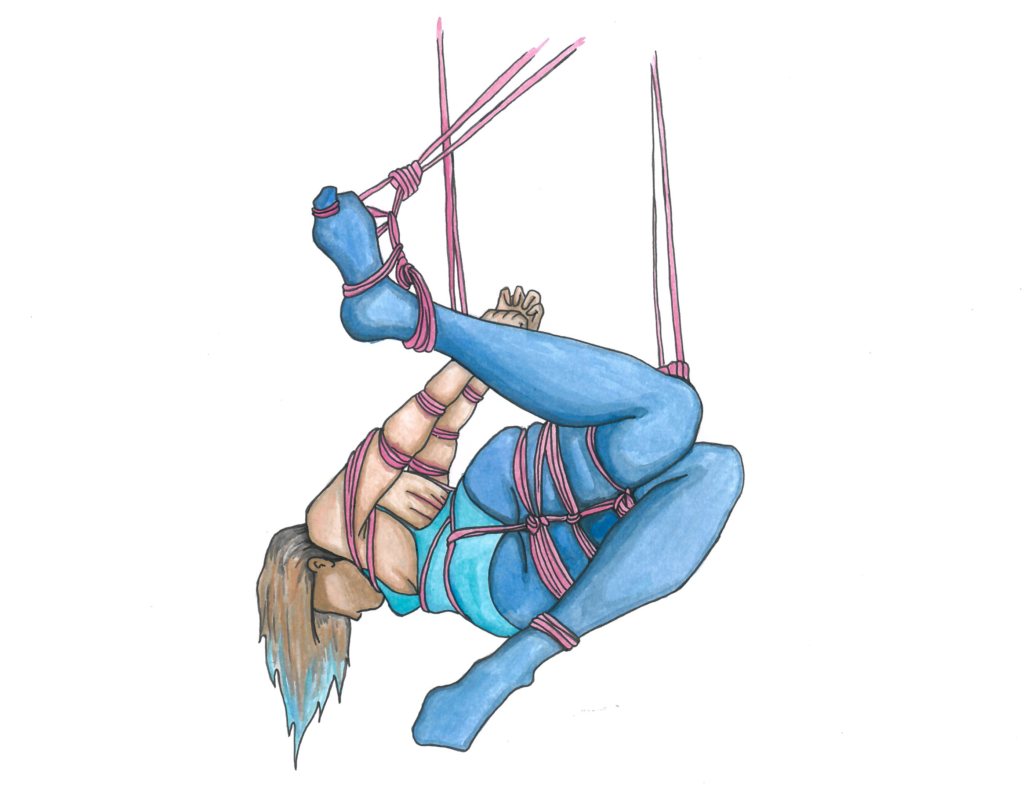
Digging more deeply into the spectrum of identity, Beatrice shared that the focus should be on how the person is feeling on any spectrum at the time of tying. As the teacher she has to learn, be open, and to figure out what inclusion can look like in any given scenario – because marginalization is everywhere. Through her own lived experience, she knows first-hand how important it is to check in with each student in each class, so that they feel free to express themselves how they feel on that specific day – that they can explore different places in their queerness. When tying, it is important to interact with the person and their feelings rather than how they look. Intersecting with queerness she sees the biggest task with her ties is to de-genderize them – to tie a person, not a traditional role. For example, tying a chest harness that is meaningful for everyone regardless of their gender identity or expression, or a harness that allows penetration by dildo – enabling exploration regardless of anatomy.
Beatrice runs classes such as an “all genders” class and a “queer” class. As a teacher, she believes one must look past the surface presentation and instead “sense” from the group how to be inclusive, so everyone is respectfully included in the space.
Anna, in her role as the facilitator for Queer Rope, considers how to generate a space which is non-binary. Rope has traditionally been male/female and top/bottom so actively building a space that is inclusive and open to everyone is important to avoid the marginalization that sometimes comes with binaries. Her focus is on rope as a kink, rather than the gender, sexuality or other identity of the people participating. The key is to include, rather than “not-exclude”. Just as Charlotte had pointed out: queerness can stick out, rather than the kink – hence Anna’s mission in creating a queer rope community where queerness is the foundation and rope is added on top.
The space that the fetish community has in the city’s Pride celebrations:
There are often questions about the place of kink in Pride celebrations. Should BDSM feature in an event that raises awareness about LGBTI+ rights and marginalization? On the other hand, why should someone’s sexual expression be denied a platform? Beatrice notes that queerness is more marginalized in society than kink – Pride is not in its essence about being kinky. Still, the kink community has a long history of participating in Pride and in activism for LGBTI+ rights. Anna expands on this in that Pride is about who you are and how you connect with people in romantic and sexual ways, and therein can lie the link to the kink.
ManiFest has been participating in Copenhagen Pride for several years. For Stephen, Pride is a place to celebrate the right to express one’s sexuality – the core value being that one has the right to honour “who I am, to be me. To support, with positive energy,” as Stephen put it. It is important because the kink community can appreciate and understand how difficult it has been for the LGBTI+ community to get to this point. Charlotte highlighted that being LGBTI+ doesn’t mean you’re not kinky … it might make it more complicated, but it can also make it more fun!
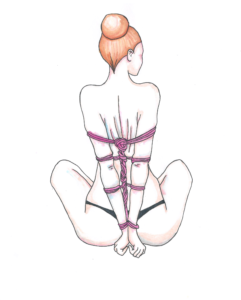
So, in the end:
Talking to Beatrice, Anna, Stephen, and Charlotte, I’ve explored more deeply the ways in which kink and fetish identity falls on a spectrum – as does queer identity. The former adds an additional layer to the queerness – a part of one’s identity to embrace in a safe, consensual, and informed manner.
Interested in finding out more about the clubs and organizers mentioned? For more information, you could reach:
Red Lily: bondage teacher and performer – redlily.dk
SMil: a BDSM association – smilkbh.dk/sm12
Excess Club: a private BDSM club – excessclub.dk
ManiFest: The largest fetish club in Scandinavia – manifest.dk
Kink events at Winter Pride 2023:
Tuesday 21 February
17.00-18.45
Queer Rope Intro (BSP event)
Language: English
Venue: Vox
19.15-21.00
Queer Rope Intro (BSP event)
Language: English
Venue: Vox
Wednesday 22 February
19.00-20.30
Kinks 101 (BSP event)
Language: Danish
Venue: Vox
